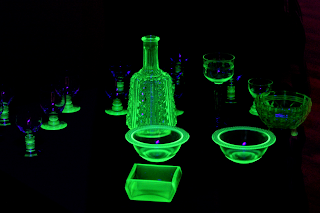Uranium glass is glass which has had uranium, usually in oxide diuranate form, added to a glass mix before melting for colouration. The proportion usually varies from trace levels to about 2% percent uranium by weight, although some 20th-century pieces were made with up to 25% uranium.
Having been first identified in 1789 by a German chemist, uranium was soon being added to decorative glass for its fluorescent effect.
James Powell’s Whitefriars glass company in London, England, was one of the first to market the glowing glass, but other manufacturers were also quick to realise its sales potential and Uranium glass was produced across Europe and later North America.
Uranium glass was once made into tableware and household items, but fell out of widespread use when the availability of uranium to most industries was sharply curtailed during the Cold War in the 1940s to 1990s.
Most such objects are now considered antiques or retro-era collectibles, although there has been a minor revival in art glassware.
 ©Fine Art America
©Fine Art America
The normal colour of uranium glass ranges from yellow to green depending on the oxidation state and concentration of the metal ions, although this may be altered by the addition of other elements as glass colorants.
Uranium glass also fluoresces bright green under ultraviolet light and can register above background radiation on a sufficiently sensitive Geiger counter, although most pieces of uranium glass are considered to be harmless and only negligibly radioactive.
Several other common subtypes of uranium glass have their own nicknames:
The use of uranium glass dates back to at least 79 AD, the date of a mosaic containing yellow glass with 1% uranium oxide found in a Roman villa on Cape Posillipo in the Bay of Naples, Italy, by R. T. Gunther of the University of Oxford in 1912.
Starting in the late Middle Ages, pitchblende was extracted from the Habsburg silver mines in Joachimsthal, Bohemia (now Jáchymov in the Czech Republic), and was used as a coloring agent in the local glassmaking industry.
Uranium glass is nowadays used as one of several intermediate glasses in what is known to scientific glass blowers as a ‘graded seal’. This is typically used in glass-to-metal seals such as tungsten and molybdenum or nickel based alloys such as Kovar, as an intermediary glass between the metal sealing glass and lower expansion borosilicate glass.
Having been first identified in 1789 by a German chemist, uranium was soon being added to decorative glass for its fluorescent effect.
James Powell’s Whitefriars glass company in London, England, was one of the first to market the glowing glass, but other manufacturers were also quick to realise its sales potential and Uranium glass was produced across Europe and later North America.
Uranium glass was once made into tableware and household items, but fell out of widespread use when the availability of uranium to most industries was sharply curtailed during the Cold War in the 1940s to 1990s.
Most such objects are now considered antiques or retro-era collectibles, although there has been a minor revival in art glassware.
 ©Fine Art America
©Fine Art AmericaThe normal colour of uranium glass ranges from yellow to green depending on the oxidation state and concentration of the metal ions, although this may be altered by the addition of other elements as glass colorants.
Uranium glass also fluoresces bright green under ultraviolet light and can register above background radiation on a sufficiently sensitive Geiger counter, although most pieces of uranium glass are considered to be harmless and only negligibly radioactive.
Several other common subtypes of uranium glass have their own nicknames:
- Custard glass (opaque or semiopaque pale yellow)
- Jadite glass (opaque or semi-opaque pale green; initially, the name was trademarked as “Jadite”, although this is sometimes over-corrected in modern usage to “jadeite”)
- Depression glass (transparent or semitransparent pale green).
- Burmese glass (opaque glass that shades from pink to yellow)
The use of uranium glass dates back to at least 79 AD, the date of a mosaic containing yellow glass with 1% uranium oxide found in a Roman villa on Cape Posillipo in the Bay of Naples, Italy, by R. T. Gunther of the University of Oxford in 1912.
Starting in the late Middle Ages, pitchblende was extracted from the Habsburg silver mines in Joachimsthal, Bohemia (now Jáchymov in the Czech Republic), and was used as a coloring agent in the local glassmaking industry.
Uranium glass is nowadays used as one of several intermediate glasses in what is known to scientific glass blowers as a ‘graded seal’. This is typically used in glass-to-metal seals such as tungsten and molybdenum or nickel based alloys such as Kovar, as an intermediary glass between the metal sealing glass and lower expansion borosilicate glass.


Post a Comment